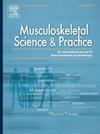Reliability, construct validity, responsiveness and minimum clinically important difference of the numeric pain rating scale and shoulder pain and disability index in patients with subacromial pain syndrome
IF 2.2
3区 医学
Q1 REHABILITATION
引用次数: 0
Abstract
Background
The numeric pain rating scale (NPRS) and shoulder pain and disability index (SPADI) are commonly used patient-reported outcome measures (PROMs) in patients with rotator cuff tendinopathy. To date, there are gaps in the evidence supporting the clinimetric properties of these PROMs for patients treated with subacromial pain syndrome (SAPS).
Methods
A clinimetric analysis (n = 145) was performed to examine the reliability, construct validity, responsiveness, interpretability, minimal detectable change (MDC95) and minimum clinically important difference (MCID) of the NPRS and SPADI for "improved" (global rating of change from +3 to +7) and "much-improved" (global rating of change from +5 to +7) patients at 3-months follow-up.
Results
The NPRS (ICC: 0.86; 95 %CI, 0.33–0.96) and SPADI (ICC: 0.79; 95 %CI 0.12–0.94) exhibited good reliability and excellent responsiveness (NPRS: area under the curve (AUC) = 0.96, 95 %CI 0.92–0.99; SPADI: AUC = 0.90, 95 %CI 0.84–0.95) in this patient population. Both outcomes demonstrated strong construct validity (Pearson's r; p < 0.001). The MDC95 was a 1.7- and 20.5-point change for the NPRS and SPADI, respectively. For the NPRS, the MCID was a 1.5-point change in the "improved" group and a 2.5-point change in the "much improved" group. For the SPADI, the MCID was an 18-point or 50 % change for the "improved" group, and a 25-point or 70 % change in the "much improved" group.
Conclusions
The NPRS and SPADI demonstrated sound clinimetric properties in patients with SAPS. The MCID exceeded measurement error in the "much improved" group. Diagnosis, type of intervention, level of improvement, and measurement error should be considered when applying the MCID.
肩峰下疼痛综合征患者数字疼痛评定量表与肩痛失能指数的信度、结构效度、反应性及最小临床重要差异
背景:数值疼痛评定量表(NPRS)和肩痛与失能指数(SPADI)是肩袖肌腱病变患者常用的患者报告结果测量指标(PROMs)。迄今为止,支持这些PROMs治疗肩峰下疼痛综合征(SAPS)患者的临床特性的证据还存在空白。方法采用临床计量学分析(n = 145),对随访3个月的“改善”(总体评分从+3到+7)和“非常改善”(总体评分从+5到+7)患者的NPRS和SPADI进行信度、结构效度、反应性、可解释性、最小可检测变化(MDC95)和最小临床重要差异(MCID)的检验。结果NPRS (ICC: 0.86;95% CI, 0.33-0.96)和SPADI (ICC: 0.79;95% CI 0.12-0.94)表现出良好的信度和良好的响应性(NPRS:曲线下面积(AUC) = 0.96, 95% CI 0.92-0.99;SPADI: AUC = 0.90, 95% CI 0.84-0.95)。两个结果都显示了很强的构念效度(Pearson’s r;p & lt;0.001)。NPRS和SPADI的MDC95分别变化了1.7和20.5点。对于NPRS,“改善”组的MCID变化为1.5点,“大大改善”组的MCID变化为2.5点。对于SPADI,“改善”组的MCID变化为18点或50%,“大大改善”组的MCID变化为25点或70%。结论NPRS和SPADI在SAPS患者中具有良好的临床性能。在“显著改善”组中,MCID超过了测量误差。应用MCID时应考虑诊断、干预类型、改善水平和测量误差。
本文章由计算机程序翻译,如有差异,请以英文原文为准。
求助全文
约1分钟内获得全文
求助全文
来源期刊

Musculoskeletal Science and Practice
Health Professions-Physical Therapy, Sports Therapy and Rehabilitation
CiteScore
4.10
自引率
8.70%
发文量
152
审稿时长
48 days
期刊介绍:
Musculoskeletal Science & Practice, international journal of musculoskeletal physiotherapy, is a peer-reviewed international journal (previously Manual Therapy), publishing high quality original research, review and Masterclass articles that contribute to improving the clinical understanding of appropriate care processes for musculoskeletal disorders. The journal publishes articles that influence or add to the body of evidence on diagnostic and therapeutic processes, patient centered care, guidelines for musculoskeletal therapeutics and theoretical models that support developments in assessment, diagnosis, clinical reasoning and interventions.
 求助内容:
求助内容: 应助结果提醒方式:
应助结果提醒方式:


